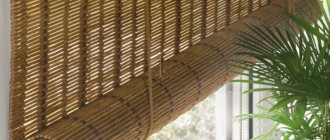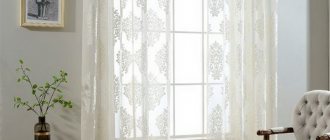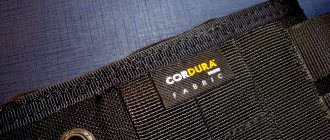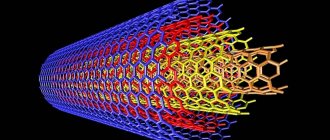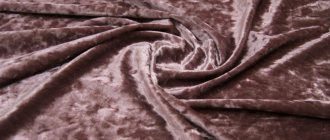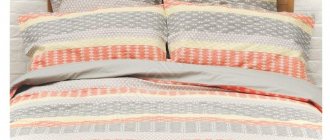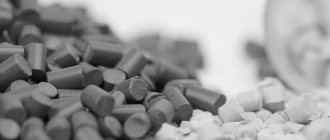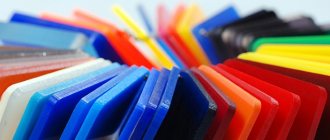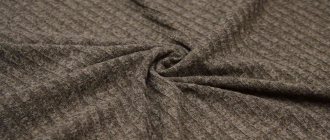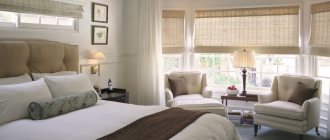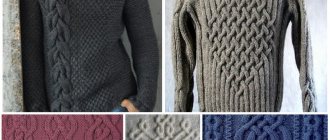Do you want practical and at the same time environmentally friendly wallpaper? Then choose bamboo wallpaper, the manufacturing technology, advantages and disadvantages, as well as the characteristics of which are described in this article.
In the modern world, where people are surrounded on all sides by a wide variety of examples of advanced technical thought, renovations with an emphasis on ecology, which is called “eco-repairs,” are becoming more and more popular.
Designers for the most part do not turn to paper wallpapers that have already become traditional, but to cork or bamboo wallpapers.
The latter will be discussed in this article. The manufacturing technology of beech wallpaper is very original and specific: they are made from natural materials, namely from a fabric base and bamboo slats on which the fabric is actually attached. The width of the slats ranges from five to twenty-five millimeters. The standard width of wallpaper is usually from one to two meters, and they are glued horizontally. However, finding wider rolls (from two to two and a half meters) in construction stores also seems to be a completely feasible task. You can stick such rolls the way you want - either vertically or horizontally.
Characteristics of bamboo wallpaper
Wallpaper is made exclusively from a special type of plant called bamboo. Moreover, in production, the top layer of the cut is used, and no other. The first stage is a good long drying, and then storing the bamboo trunks in a special room with the proper temperature level, which remains unchanged throughout the entire storage period. At the second stage, the upper cut of the trunk is split and jointly removed, after which the cut is glued onto a fabric base.
What is curious is that such characteristics of wallpaper as texture and color depend mainly on the time of collection, as well as on the technologies with which the material is processed and on its type. Black and generally dark colors are obtained through heat treatment of slats, but light colors are a product of processing natural colors.
The palette of shades of beech wallpaper is quite diverse. They come in brown (golden brown, dark copper and even red), light, green (ranging from soft greenish to brownish green), yellow (peach and creamy beige shades).
What is bamboo fabric
Bamboo is an evergreen perennial plant with a hard, woody, hollow stem.
Bamboo fabric is used not only in textiles
There are hundreds of varieties that are successfully used in various areas of human activity - from construction to medicine.
Natural bamboo
Note! Bamboo is a wonderful and highly versatile natural resource. It has been used for many centuries in Asia in a variety of applications, including cooking, construction, transport, textiles and medicine.
Bamboo fiber can be used to make exceptional modern textiles.
Bamboo wallpaper: features
Modern interior design tends to use natural materials. For the popular trends of eco-design, Provence, country, minimalism, and Japanese style, natural wall coverings made from bamboo wallpaper are ideal. The variety of natural colors and textures, environmental friendliness and aesthetic appearance ensure high demand for natural wallpaper.
conclusions
- Bamboo fabric is an absolutely safe plant material that is suitable for small children and allergy sufferers.
- Fibers from the Chinese plant are used to make clothing, wallpaper, bed linen and even tableware.
- Easy to maintain and has a long service life.
- Products made from the linen of the Chinese plant are an expensive pleasure that not everyone can afford.
- Even after repeated washings, it does not lose color.
- Clothing and bedding made from bamboo threads can be machine washed.
Advantages and disadvantages
Natural wall wallpaper will decorate the interior and highlight the design of a room of any style, focusing on environmentally friendly design. Bamboo wallpaper has undoubted advantages:
- Environmentally friendly material - bamboo wallpaper is made from natural materials and does not cause allergies.
- Beautiful natural texture - for one batch of wallpaper, bamboo stems are selected from the same variety, manufacturers carefully select bamboo slats of the appropriate texture and shade.
- Wide color palette - the color of bamboo slats depends on the location of the plant, the time of collection, and the initial drying temperature, so the color palette of wall coverings can range from soft white to rich brown shades.
- Easy to clean and antistatic – the coating does not attract or absorb dust. Sometimes manufacturers coat the slats with antistatic impregnation, which makes cleaning the coating easier.
- Long service life - high-quality wallpaper, if the fastening technology is followed, will last up to 10 years, since the material is not subject to fading when exposed to sunlight and has anti-vandal properties.
- Hide wall unevenness - due to its dense structure and thickness, wallpaper can hide minor defects and unevenness, and therefore does not require perfect alignment of the walls.
- Glue to various surfaces - can be glued to wood, putty, plastic, cement and other surfaces using only a primer and the required type of glue or liquid nails.
The disadvantages of bamboo wallpaper include the following aspects:
- High price - natural materials undergo a number of labor-intensive and energy-consuming stages of drying and preparation for use, which determines their high cost.
- Difficulty when attaching to the wall - wallpapering must be done in stages, following the manufacturer's recommendations. It is better to entrust such painstaking work to a professional.
- It’s a boring look to completely cover a room with one type of covering - designers do not recommend covering walls with one type of wallpaper. It is better to use bamboo as panels in a room or to create decorative panels, combining them with cork or other types of wallpaper.
- Surface irregularities – on the surface of bamboo slats, there may be bulges and compactions in the structure. Such defects are not considered defective, but can complicate the process of joining seams and gluing.
When choosing bamboo wallpaper as a room decoration, you should consider the pros and cons of this finishing material. Designers and repairmen recommend using them in the hallway, living room, corridor, and kitchen.
This type of wall covering can be used in any living room and non-residential premises (offices, reception areas, cafes) to maintain the environmental friendliness of the interior and create an atmosphere of comfort and warmth.
What is the difference between bamboo and cotton and eucalyptus fiber: which is better?
Bamboo and eucalyptus are modern and environmentally friendly materials. But each of them has its own characteristics and properties. They are hypoallergenic, durable, and have antibacterial properties.
The cost of a fiber blanket with a size of 140*205 is 1560 rubles.
It’s difficult to say exactly which is better, but a pillow with eucalyptus is saturated with essential oils that normalize sleep. There is no such thing in a bamboo product, although the cost of a pillow with eucalyptus is much more expensive.
Manufacturing technology
Bamboo contains a high percentage of moisture (up to 80%), so to produce high-quality and durable wall coverings, the raw materials undergo a long processing process.
Only the young part of the stem shoot is used for wallpaper production. The drying process is divided into two stages:
- The stems are auditioned in a room with a constant temperature and humidity of about 45%. This humidity ensures the strength and elasticity of the material and prevents it from cracking due to rapid loss of moisture.
- the raw materials are finally dried in the warehouse.
The drying process is one of the most responsible. Depending on the temperature and drying speed, bamboo changes its shade and color. After this, the stem is split into upper and inner parts, which are straightened out under slight pressure and glued to the base of the future roll of wallpaper. The width of bamboo slats can vary from 5 to 25 mm. The base can be fabric or paper. When gluing, natural-based glue is used.
The finished wall covering is produced in rolls of standard sizes with a width of 1, 1.5, 2 m. Rolls 2-2.5 m wide are less commonly found in stores. Sometimes wallpaper is produced not in rolls, but in sheets, ready for pasting in the form of panels in room. Sheet panels are fragile and require special conditions for transportation and storage, but this type of finish is immediately ready for gluing and does not require time for leveling.
In the wallpaper production process, exclusively natural materials are used. For additional decoration, stitching of slats with the base of the wallpaper is used with a contrasting or textured thread along the edges of the canvas. The surface retains the natural ventilation of the wall covering, and the overall color is selected by selecting each element according to tone and texture.
Kinds
Types of bamboo wallpaper are differentiated according to the materials of the bamboo trunk used for covering:
- From the outer part of a bamboo trunk.
- From the inside of the trunk.
The structure of the wood is clearly visible on the outer layer. Such wall coverings have a denser structure and resemble bamboo columns when wallpaper slats are glued vertically. Imitation of bamboo stems visually enlarges the room, adds volume to the space and height of the room.
The outer layer is distinguished by texture, unique pattern and color. The color of the top layer is heterogeneous, which gives the surface volume and depth. These types of wallpaper are not covered with varnishes and paints, maintaining a natural appearance.
The wallpaper strips from which the top layer has been removed are more accurately matched by color. For greater practicality, manufacturers coat the wallpaper with varnish. The varnished surface is moisture resistant and easy to clean.
For greater practicality, wallpaper slats can be stitched with decorative thread along the edges. Firmware not only provides additional fastening to the base, but is also an additional decorative element in the design of the room.
Color
The color of bamboo wallpaper depends on many factors. The color shade of the finished natural wallpaper canvas is influenced by:
- Plant variety.
- Place of growth.
- Time to cut stems.
- Temperature and humidity of the initial drying stage.
Natural bamboo wallpaper is available in the following colors:
- Shades of white - white, ivory, emerald, milky, etc.
- Green – bright and rich shades of green will bring a spring mood to any room. Soft green, the color of spring grass, green-brown, pistachio shades are the most common colors of bamboo sheets.
- Beige – there are rare colors with pink-peach, yellow-honey shades.
- Brown – The natural colors of bamboo slats range from light brown and café au lait to rich brown.
What properties does the material have?
Bamboo fabric what is it? Viscose fabric is generally shiny and smooth. It feels soft and delicate. Despite this, the fibers are very strong and dense, which means that textile products practically do not wrinkle and drape perfectly.
The fabric made from this material allows air to pass through, maintains temperature conditions, has antibacterial properties, is not static, due to which it is perfect for making men's and women's clothing, underwear, it is used as a filler, and it makes good yarn.
Natural fiber
SUBTLETS AND NUANCES OF TECHNOLOGY FOR Gluing BAMBOO WALLPAPERS
SURFACE PREPARATION
Bamboo wallpaper is more rigid than classic paper and polymer lining materials. They do not stretch in places of small bulges on the walls and can “move away” after some time if the surface has not been sufficiently prepared.
Before gluing, you should level the wall, removing both small protrusions and large bends. For this purpose, cement plaster is usually used, which has the best price-strength ratio. Small depressions are covered with mortar or finishing putty. The previous layer of wallpaper must be carefully scraped down to the concrete base.
Before applying bamboo sheets, the walls are treated with a deep penetration primer. It serves as an intermediate layer between heavy wallpaper and the surface, providing the necessary adhesion. This primer is often sold under the guise of a specially selected composition for bamboo wallpaper, although in fact you can use any available composition for gluing.
SELECTION OF GLUE
The quality of the resulting coating directly depends on the degree of preparation of the base and the properties of the adhesive composition. Several types of glue are suitable for applying bamboo wallpaper:
- polyvinyl acetate compositions (PVA) - represented by water-soluble dispersions intended for rooms with dry air (not recommended for use in kitchens and bathrooms);
- parquet glue – a standard option for gluing large areas;
- “liquid nails” – form the most durable adhesive base;
- rubber adhesive is an environmentally friendly and waterproof composition suitable for gluing not only walls, but also ceilings.
Applying glue to bamboo wallpaper
GLUE TECHNOLOGY
Applying bamboo wallpaper to walls is similar to gluing their paper and vinyl counterparts, but has some differences. Before carrying out work, purchased rolls must be kept for 2-3 days in the room in which they are planned to be used. This will avoid warping of the bamboo sheet due to changes in humidity and possible shrinkage.
Before gluing, you should stock up on the following materials and tools:
- wallpaper and glue, taken with a slight excess;
- strips to hide the joints. In most cases, it is necessary to cover only the external and internal corners (bamboo wallpaper cannot be rolled up), leaving the joints on the planes of the walls;
- a stepladder for working at the top of the room;
- a trowel or a hard brush with polymer fibers for applying glue;
- a retractable sharp knife or scissors for trimming wallpaper and removing dried adhesive smudges;
- cotton rags or roller for leveling the fabrics.
VIDEO: Gluing BAMBOO WALLPAPER
When gluing bamboo wallpaper you must:
- Make sure the surfaces to be glued are even and dry. Most adhesives have poor adhesion to wet substrates;
- Unroll the wallpaper roll and cut it to the height of the wall (the width of the ceiling);
- Apply glue to the wall and canvas, then let them dry for 5-10 minutes. Bamboo material adheres worst to the edges of the strips, so the amount of glue should increase from the center of the strip to the edge;
- press the canvas against the wall, moving from its top to the bottom;
- ensure a snug fit of the strip by leveling with a roller or rag. Based on the experience of the first glued canvas, you can estimate the amount of glue required for high-quality gluing. Excess adhesive mixture should not leak out when leveling;
- upon reaching the corner of the room, you should mark the cutting line by attaching the original canvas to the place of pasting. Wallpaper should be trimmed on the floor, trying not to go beyond the intended line. The resulting narrow strip is fixed in the same way as the previous one;
- while the wallpaper is drying, drafts must be avoided to prevent uneven evaporation of the solvent and the “lag” of the canvas;
- After the glue has dried, platbands matched to the wallpaper pattern are glued to the corner joints. You can begin painting the bamboo covering after completing the pasting work, using the coloring compounds recommended by the wallpaper manufacturer.
Hanging bamboo wallpaper is an original way to update the design of a room while maintaining the aesthetics and durability of its finish. When gluing walls, attention should be paid to the quality of the adhesive base and preliminary preparation of surfaces. Compliance with basic recommendations for working with bamboo wallpaper is the key to its long-term and effective operation.
Additional steps after wallpapering
Bright and airy pictures of bamboo, which are easy to find on the Internet, are obtained only with strict adherence to wallpaper installation technology. Approximately 2-3 hours after completion of the main work, it is necessary to carefully check the quality of the setting that has occurred. To do this, you need to gently tap with your palm on the areas that cause the most doubt. If necessary, they should be leveled using a roller.
There are situations when a certain cavity forms under the canvas. This problem is also quite easy to fix if noticed early. To do this, you need to take the adhesive into a syringe and easily inject it under the wallpaper. After this, you need to use the leveling roller again.
By following all the recommendations, you can achieve excellent results and, thanks to bamboo wallpaper, transform any interior beyond recognition
It is better to learn the exact rules for gluing bamboo wallpaper by watching training videos. Particular attention should be paid to the features of placing the canvas on the wall surface. Photos of bamboo blinds, which look quite original in any interior, also attract attention.
In the end, a fair conclusion should be made that bamboo wallpaper is a universal material that has many advantages over its competitors. This type of fabric is environmentally friendly, durable, practical and very attractive.
Such wallpaper can be placed in living rooms and even children’s rooms without any problems. The pasting procedure does not change significantly. The main requirement for craftsmen is the need to handle the canvas as carefully as possible. This material is excellent, which is why it deserves increased attention. You can achieve excellent results by strictly following the recommendations of specialists.
How to choose?
Decorating with natural wallpaper in rolls begins with determining the area to be covered: completely covering the room or using a bamboo panel. The number of rolls should be taken in excess and from one batch.
Natural wallpaper is often used in eco-design, so designers recommend combining the color of bamboo wall coverings with the color of furniture, floors, door veneer and window frames.
On a balcony, loggia, or terrace, bamboo trim should organically match the color of wicker rattan furniture.
Designers recommend supporting the natural wall covering with additional accessories: straw blinds, young bamboo shoots in a glass vase, textiles with a natural print.
Reviews from owners of interiors made from natural materials indicate that completely covering walls with bamboo wallpaper on a fabric or paper basis looks quite boring and visually reduces the space. Both designers and homeowners who are not indifferent to the interior design of their homes agree that a panel of bamboo wallpaper framed with moldings, or a combined panel of bamboo wallpaper and cork panels look dynamic and stylish in any interior style.
Production technology
To produce high quality bamboo sheet, a process must be used that uses sodium hydroxide, also known as caustic soda, to break down the "woody" bamboo. Chopped bamboo is soaked in a special composition to obtain cellulose.
Versatile environmental material
Fiber obtained from bamboo is the fragmented particles left behind when wood shavings are removed. The resulting particles are then treated with alkali.
This method is used to soften cellulose, which becomes glue-like under alkali pressure.
Bamboo grows very quickly, at a rate of 15-20 m per month. Due to this, cutting down the bamboo forest does not cause much damage to nature. As a result, production from bamboo does not suffer losses, and the end consumer can purchase products from this wood at a low price.
You may be interested in what kind of fabric is used for a wedding dress
Natural bamboo wallpaper
Attention! Bamboo fabric has such qualities as naturalness, hygroscopicity, and an antibacterial effect.
The resulting composition is an ideal filling for pillows and quilts, textiles, and household textiles. Often on the tags you can see the designation - bamboo viscose.
Products made from such material always have the same density, the material is durable. But producing such fiber can sometimes be quite difficult – if we are talking about an environmentally friendly method. Increasingly, production is opting for chemical processing of raw materials.
Variety of styles with bamboo fabric
Options in the interior
Bamboo wallpaper adds comfort and beauty to the bedroom. It is easy to fall asleep in such a room, strength is quickly restored thanks to the natural materials and calm natural colors.
In a Japanese-style bedroom design, a bamboo panel at the head of the bed will be an indispensable attribute. It will be a worthy addition to white walls and rice panels framed by solid wooden slats.
The eco-style of the living room is supported by separate sand-beige panels. Such discreet wallpaper will serve as the basis for decorative bright elements in the room (pillows, a screen made of natural bamboo stems, photo wallpaper).
A laconic and discreet high-tech kitchen will look cozy and homely against the backdrop of bamboo-covered walls.
A classic traditional option for using sheets in the design of the hallway of an apartment or house. Entire hallway walls covered with bamboo wallpaper do not look boring thanks to mirrors and furniture in a minimalist style made of natural wood.
Design options
When purchasing natural bamboo products, you need to take into account some features in interior decoration. So, for example, to give the room a classic, austere look, it is recommended to choose products in a cool shade. And to create coziness and warmth in the room you will need a golden color. In addition, it is worth paying attention to other materials that are used in decoration. Bamboo harmoniously combines with fabric-based wallpaper, suspended ceilings, original accessories and various sculptures.
When decorating a room, it is not necessary to cover the entire wall with bamboo wallpaper; it is enough to just cover a small area with it and make it the main accent in the room.
Each room, depending on its style, can be decorated differently with this exotic material. There are many options for wall decoration, the most popular of which are:
Bedroom
This is a special room in the house, so in its interior, first of all, attention is paid to the color and type of material. This room should be filled with a cozy and relaxing atmosphere. Therefore, to decorate the walls you need to choose a green, brown or yellow shade. Wicker wallpaper, as well as cork fabrics with unusual patterns, look beautiful in the bedroom.
To create an original corner in the bedroom, you can make compositions from butterflies or sakura branches. They are installed above the head of the bed in the form of a wide strip. The resulting pattern will look harmonious against the background of walls covered with veneer. This decor will be perfectly complemented by straw or cork wallpaper.
It is important to take into account the distance of the decor to the ceiling - if it is small, then the bamboo slats are placed vertically, if the ceiling is high, then the canvases are mounted horizontally.
Thick bamboo stems look good in bedrooms located in the attic; their color should match the furniture in the room. As a rule, preference should be given to simple and massive modules made of natural wood. The interior of such a bedroom should consist of light parquet flooring, wide roller shutters on the windows and bamboo wall panels.
As for the colors of the canvases, in this case beige and coffee colors with a small pattern are suitable.
Hallway
In such a room, it is important to combine the texture of the wallpaper with furniture and various accessories. The lighting of the room plays a huge role here, since the beauty of the drawings on the canvases will depend on it. Dim light in the hallway will turn the wallpaper into one shadowy spot.
Sand, chocolate or cherry colored products are well suited for such a room.
The decor of a hallway decorated with this type of wallpaper should not be limited to just one traditional wardrobe; in order to dilute the dull atmosphere in the room, it is recommended to use wicker furniture . If the room is large, then it is good to fill it with bright ottomans, which against the background of wall panels will look great, reminiscent of African style. It is good to complement the interior with drawings with hieroglyphs and indoor plants with large leaves. You can cover the walls of the chest of drawers with the material, and decorate the mirror attached above it with sea shells.
Kitchen
Bamboo wallpaper is easy to maintain, so it is perfect for this room. To clean their surface, just use a vacuum cleaner or a dry cloth. At the same time, you cannot use detergents for cleaning, as their chemical composition can cause harm to the products.
The best place for wallpapering is considered to be the eating area; it must be decorated in an oriental style, using Japanese glassware and black furniture.
To make the kitchen as cozy as possible, the canvases are selected in combination with the furniture. Additionally, the room is decorated with painted dishes. The walls are decorated with chocolate-colored wallpaper, and furniture is chosen with a glossy surface. This creates an unusual contrast and fills the room with homely warmth and comfort.
Types of hemp fabric
Each type of bamboo thread has its own properties, as well as scope of application.
Bamboo silk
It is obtained from bamboo cellulose with the addition of special enzymes. It is the latter that makes the fabric look like twill.
The main advantage of bamboo silk carpets is their environmental friendliness and safety.
No chemical compounds are used in the manufacturing process, so the products are environmentally friendly. The mother is used mainly to make clothes for summer.
swansdown
Obtained artificially as a result of the use of innovative technologies. The quality of swan down is in no way inferior to natural raw materials and even surpasses it in some respects. The material is practical and safe for human health.
Cosca bamboo fabric
Used to create an original design in an oriental style. The canvas is indispensable for finishing ceilings, walls or furniture. The front or inner part of the bamboo trunk is used to make the canvas.
